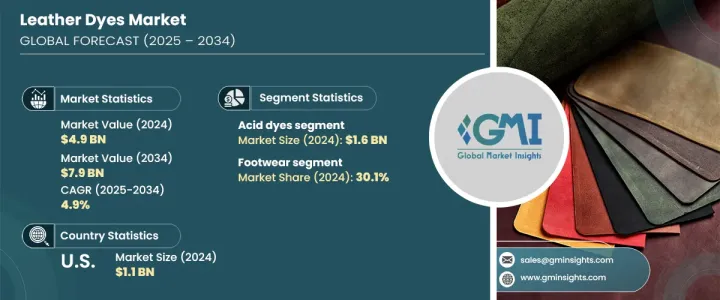
세계의 피혁 염료 시장은 2024년 49억 달러에 달했고, 2025년부터 2034년까지 연평균 복합 성장률(CAGR) 4.9%로 성장할 것으로 예측됩니다.
이 시장을 견인하는 것은 특히 자동차 인테리어, 패션, 럭셔리 제품 등 고급 가죽 제품에 대한 수요 증가가 있습니다. 자동차 산업이 자동차 인테리어의 고급스러움과 안락함을 높이기 위해 고품질의 가죽을 선호하기 때문에 선명하고 오래 지속되는 염료의 필요성이 크게 증가하고 있습니다. 또한 친환경적인 피혁 염료에 대한 선호도가 증가함에 따라 지속가능성이 여러 산업에서 필수적인 요소가되는 중요한 역할을 수행합니다. 소비자의 환경 의식이 높아짐에 따라 효과적이고 친환경적인 염료로의 전환이 두드러지고 있습니다.

럭셔리 브랜드는 지속가능성뿐만 아니라 가죽 제품의 품질과 장인 기술도 중시하고 있기 때문에 럭셔리 패션 분야는 피혁 염료 시장을 더욱 밀어 올리고 있습니다. 고급 가죽 제품에 대한 수요가 증가함에 따라 친환경적인 제조 방법으로의 전환은 혁신적이고 지속 가능한 염료 솔루션의 필요성을 가속화하고 있습니다. 게다가 가처분 소득이 세계적으로 증가함에 따라 소비자는 고급 가죽 제품에 대한 투자를 늘리고 시장 성장을 가속하고 있습니다. 또한, 피혁 염료 시장에서는 염색 기술의 진보도 볼 수 있어 생산자는 다양한 가죽 용도에 고품질이고 내구성이 있어 선명한 염료를 제공할 수 있게 되어 있습니다. 이러한 요인들이 결합되어 시장은 품질, 지속가능성, 세련된 가죽 제품에 대한 수요가 증가함에 따라 번창하고 있습니다.
| 시장 범위 | |
|---|---|
| 시작 연도 | 2024년 |
| 예측 연도 | 2025-2034년 |
| 시작 금액 | 49억 달러 |
| 예측 금액 | 79억 달러 |
| CAGR | 4.9% |
피혁 염료 시장은 유형별로 구분되며 산성 염료, 매염 염료, 직접 염료, 염기성 염료, 프리메탈 염료 등을 포함합니다. 2024년에는 산성 염료가 최대 시장 점유율을 차지해 16억 달러의 수익을 올렸습니다. 사용의 용이성, 생생한 발색, 세탁 및 퇴색에 대한 강한 내성으로 알려진 산성 염료는 가죽 응용 분야에서 특히 선호됩니다. 색의 안정성이 평가되는 매염 염료와 보다 비용 효율적인 옵션을 제공하는 직접 염료도 시장에 크게 기여하고 있습니다. 선명하고 인상적인 색상으로 알려진 염기성 염료와 내구성으로 알려진 프리 메탈 염료는 시장을 더욱 풍부하게 만듭니다.
용도별로 피혁 염료 시장은 신발류, 자동차 인테리어, 가구 인테리어, 의류, 가방 등으로 분류됩니다. 2024년에는 신발류 분야가 30.1% 시장 점유율을 획득했습니다. 패션과 쾌적성으로 가죽 신발류 수요가 증가하고 있는 것이 이 분야의 주요 추진력이 되고 있습니다. 피혁 염료는 신발, 부츠, 샌들의 미적 매력을 높이는 데 필수적이며 소비자는 다양한 색상과 마무리를 요구합니다. 맞춤형 럭셔리 신발에 대한 동향 증가와 친환경적인 염색 기술의 진보가 이 부문의 성장을 더욱 향상시킵니다.
미국의 피혁 염료 시장은 2024년 11억 달러에 이르렀으며, 신발류, 자동차 인테리어, 가구 등 주요 부문이 수요를 이끌고 있습니다. 패션 및 럭셔리 제품 분야에서 고급 가죽 제품에 대한 소비자의 관심이 계속 증가하고 있기 때문에 시장 성장은 계속 견조하게 변할 것으로 예상됩니다. 게다가 지속가능한 염색기술의 혁신은 시장의 미래 궤도를 형성하는데 필수적인 역할을 합니다.
The Global Leather Dyes Market reached USD 4.9 billion in 2024 and is projected to grow at a CAGR of 4.9% between 2025 and 2034. The market is being driven by rising demand for premium leather products, particularly in automotive interiors, fashion, and luxury goods. As the automotive industry continues to prioritize high-quality leather to enhance vehicle interiors' luxury and comfort, the need for vibrant, long-lasting dyes has increased significantly. The growing preference for eco-friendly leather dyes also plays a crucial role as sustainability becomes an essential factor across multiple industries. With consumers becoming more environmentally conscious, there is a marked shift toward dyes that are both effective and eco-friendly.

The luxury fashion sector further boosts the leather dyes market, as high-end brands emphasize not only sustainability but also the quality and craftsmanship of their leather goods. This shift towards eco-conscious manufacturing practices, alongside the rising demand for exclusive leather products, accelerates the need for innovative and sustainable dye solutions. Additionally, as disposable incomes rise globally, consumers are increasingly investing in premium leather products, thereby driving market growth. The leather dyes market is also witnessing advancements in dyeing technologies, which enable producers to offer high-quality, durable, and vibrant dyes for various leather applications. These factors combined underscore a market thriving on quality, sustainability, and the growing demand for fashionable leather products.
| Market Scope | |
|---|---|
| Start Year | 2024 |
| Forecast Year | 2025-2034 |
| Start Value | $4.9 Billion |
| Forecast Value | $7.9 Billion |
| CAGR | 4.9% |
The market for leather dyes is segmented by type, which includes acid dyes, mordant dyes, direct dyes, basic dyes, pre-metalled dyes, and others. In 2024, acid dyes held the largest market share, generating USD 1.6 billion in revenue. Known for their ease of use, vibrant color production, and strong resistance to washing and fading, acid dyes are particularly favored for leather applications. Mordant dyes, valued for their color stability, and direct dyes, which offer a more cost-effective option, also contribute significantly to the market. Basic dyes, recognized for their bright and striking colors, and pre-metalled dyes, known for their durability, further enrich the market.
By application, the leather dyes market is categorized into footwear, automotive interiors, furniture upholstery, garments, bags, and others. In 2024, the footwear segment captured a 30.1% market share. The increasing demand for leather footwear in both fashion and comfort sectors is a key driver here. Leather dyes are vital for enhancing the aesthetic appeal of shoes, boots, and sandals, with consumers looking for an array of colors and finishes. The growing trend toward customized and premium footwear, along with advancements in eco-friendly dyeing techniques, has further contributed to this segment's growth.
The U.S. leather dyes market reached USD 1.1 billion in 2024, with key sectors such as footwear, automotive interiors, and furniture driving demand. As consumer interest in high-end leather products continues to rise in the fashion and luxury goods sectors, market growth is expected to remain strong. Moreover, innovations in sustainable dyeing technologies are playing an integral role in shaping the market's future trajectory.